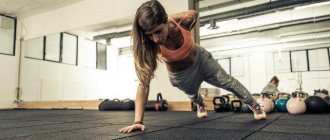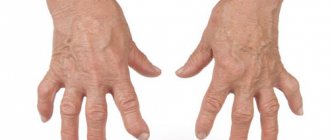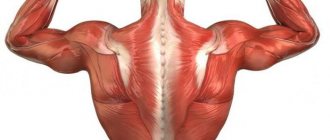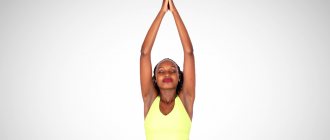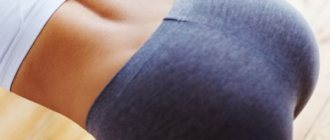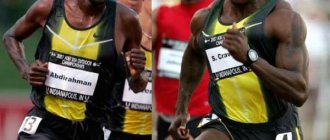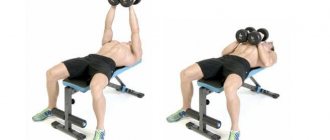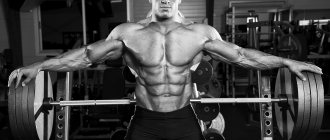Effect of arm length
Roughly speaking, there is no such thing as a single correct grip for the bench press, since it will differ depending on your goals and individual characteristics.
For example, the width of your grip depends in part on the length of your arms.
The longer a person's arms, the more work he will have to do to move the bar from the chest to straight arms. The length of the arms also affects the distance between the palms when gripping. The relationship here is direct - the longer the arm, the farther the hands on the bar will be from each other.
This is explained simply: when a person presses a barbell in the classic version, he must bend his elbows 90 degrees in the starting position. It turns out that the distance between the palms clearly depends on the length of the arms from shoulder to elbow. The width of the chest also affects what the grip will be, but only slightly.
Width of brush placement
The best known exercises are the wide-grip barbell bench press, the medium-grip bench press, and the last option with a narrow grip.
Let us remember that the basic bench press with an emphasis on the pectoral muscles is done with a wide grip, an intermediate version in which the load is distributed between the chest and arms is done with a medium grip, and the triceps or inner chest is pumped with a narrow grip.
On a classic bar weighing 20 kg there are grooves (marks) that determine the place of the index or any other fingers.
The width of the grip in the bench press is determined, firstly, by the goal (which muscles you are pumping), and secondly, by the length of your arms. To get the barbell you really need, use an empty bar first.
With the classic bench press. Lie down under the apparatus, position yourself on the bench so that your eyes are exactly under the bar. Now place your hands on the barbell in the area of the marks. Do the bench press several times and determine the most comfortable position for your hands. Remember which fingers are at risk. This will allow you to start working with the projectile right away next time.
https://youtu.be/Ach1vYKTzBE
The index finger, ring finger, or any other finger may be at risk. Your task is to grasp it so that your arms do not move apart, but it is also comfortable for your elbows to move apart. For example, with a height of 187 cm, I’m at risk with my middle finger. When I'm tired - nameless. For those who are shorter, the risk is located under the ring finger or little finger. In general, see for yourself.
When bench pressing with a close grip, it is important to grip the bar so that the bar maintains balance and does not fall to either side. The approximate distance between the hands is 20–30 cm. During the movement, your elbows will be brought towards the body. In this position, the triceps work effectively, and along with them the shoulder muscles (deltoids), namely the anterior bundles. And the lower you lower the bar from neck level, the more the deltoids will be loaded.
The medium grip is a kind of intermediate option. The elbows are slightly away from the body when moving.
Different grip:
If the weight of the barbell is too heavy, athletes use this type of grip, in which one hand is turned out as in a regular grip, and the other is with the palm facing away from you. This type of grip really helps to support even more weight. But there are also unpleasant nuances here:
- Violation of body symmetry. One side of the body, if used frequently with this grip, may eventually become lower than the other. In simple terms, this is called “curvature of the spine.”
- Promoting torque generation. The bar turns, so to speak, in one direction. This moment is transmitted to the spine, unnecessarily loading it.
Open and closed grip
Typically, when doing a bench press, athletes hold the bar in a ring, wrapping 4 fingers on one side and the thumb facing them. This grip is safe - the bar will not roll off your hands and onto your chest.
There is another interesting option that can help you press more weight. And it consists in not placing your thumb towards the rest. That is, the bar is wrapped around all 5 fingers and lies on the palm.
However, if used improperly, the bar can slip off your palms and fall onto your chest - after all, it is not fixed in any way except by the bends of your palm. Therefore, if you are a beginner, you do not need to use an open grip. Dumbbells should not be held like this under any circumstances.
Another serious disadvantage of such an open grip is the large load on the wrist joint, which bends strongly back so that the barbell does not roll off the palm. With a normal grip, the bar lies in the palm of your hand, covered with your fingers on both sides. There is nowhere for him to roll, and there is no point in bending his wrist either. And in this case, the position of the bar depends on the bend of your hand.
https://youtu.be/MEVbPBx7UzY
The hands experience a similar unpleasant load, in particular, during a frontal squat, when it is more convenient for a person to cross his arms, but he still keeps his elbows parallel to each other.
Strength is in the grip: learning how to properly develop your hands
Nail Tuktaroff
Apr 4, 2020 · 6 min read
The most impressive thing in grip strength competitions is holding two 45-pound plates off a barbell (total weight 41 kg) with your fingers. It would seem simpler: take a couple of discs with the smooth side facing out and squeeze them between your thumb and the rest (for American discs, one side is convex and the other is completely smooth). Then lift it to hip level and hold. But what in reality? The surface of the discs challenges even the strongest people.
But it's a challenge worth taking on (start with at least 2.5 kg weight): studies have shown a link between weak grip strength and a high risk of cardiovascular disease, as well as, as usual, the prospect of early death. And if you don’t look that far, then we can say that a weak grip is at least a path to injury. “It's often your hand strength that limits your ability to lift weights,” says Jedd Johnson, five-time winner of the Grip Sport North American Championships. Well, how to develop it? There are several options.
Every time you lift weights, squeeze the barbell, or dumbbells, or horizontal bar as hard as you can. “Crush the bar soft-boiled,” says Pavel Tsatsouline, trainer and director of StrongFirst. If you do exercises with one arm, for example, bent-over dumbbell rows, enhance the effect by squeezing the hand that is currently cooling.
Use thick bars or special thickening attachments when doing deadlifts and generally all pulling exercises. Don't have such necks or attachments? Jesus, wrap a towel around the bar and the weight will become harder to hold. Typically twice as thick, the bars force you to squeeze your wrist harder to get a good hold, so even relatively light weights go harder with them, says Jedd Johnson.
Strength coach Dan John advises everyone who wants to develop a real man's handshake to add one simple exercise to their routine, which should be done once a week. Pull yourself up on the horizontal bar and hang on it for 30 seconds. Pull yourself up again and hang again. And so on until you can no longer do pull-ups, hang, or even read this magazine. To do ten pull-ups in this exercise, you will have to hang on the horizontal bar for more than five minutes - and this will give you hellish grip strength.
To control the movement of one hand, the motor cortex of our brain triggers the work of more than 30 muscles. To maximize the effectiveness of your workouts, don't limit yourself to barbells or dumbbells. "Whether it's a towel draped over a bar, a thick rope, or a piece of plastic pipe, they all place different demands on your grip," says fitness consultant David Jack. Every week, do at least three sets of pull-ups on towels, rows using thick ropes or thick pipes.
The muscles on the back of your forearm work to open your fingers and bend your hand back.
Workout: Open your palms and spread your fingers wider. Try to bend your palms slightly back. Hold your arms in this tension for 30 seconds, then rest, then repeat.
These muscles help you grasp and squeeze, key actions in almost all sports.
Try weighted wrist curls or any of the challenging exercises below.
They help compress the thumb. These muscles clearly don't get enough love from regular gym sessions.
Train them. Holding the discs away from the barbell with your fingertips. Start with 2.5 kg ones. Bring the hold to 60 seconds.
The gold standard is to hold the discs with the smooth side facing out. However, this is not the only way.
A bit heavy? Then turn the discs with the smooth sides facing inward. You train the thenar muscles in the same way, it will just be easier to hold.
Use a multi-grip to lift heavy weights
On easy approaches, use a straight grip (with the inside of your palms facing you), and on heavy approaches, use a different grip: one palm is turned towards you, the other - away from you. This will ensure a more secure hold on the bar throughout the entire movement. On each approach, change your hand grips (the one who held the barbell with a direct grip in one approach will hold it with a reverse grip in another) to avoid distortion in the back.
Hold the bar with your thumb, no monkey grip.
A monkey grip (the thumb does not wrap around the bar, but remains on the same side as the other fingers) is sometimes recommended for greater shoulder comfort, but it is fraught with problems: the bar can stupidly slip out of your hands. Always wrap your thumb around the bar and keep the distance between your hands. When lowering the barbell to your chest, your forearms should be perpendicular to the floor.
Lock grip is not the best option
Stick to a standard overhand grip, with your thumb wrapped around the bar and pressed firmly against your other fingers. Professional athletes can recommend a lock for performing a snatch and clean of a barbell - this is when the index, middle and other fingers are placed on top of the thumb. But if you're a newbie, it's best to be careful.
Hands should be wider than hips apart
It all depends on the position of the hands. To determine the optimal position, take the bar and lower it until it is level with your hips. The thumbs should rest on the bar, pointing towards each other. The position of the hands should be such that the outstretched thumbs touch the hips. This will ensure the best position for your arms when the barbell is on your chest.
Having trouble holding a barbell? What about the belts?
You need to hold the barbell in front of you at shoulder level using an overhand grip. If this exercise causes pain in your shoulders, elbows, or wrist, use wrist straps or a rope around the bar. Hold the straps by the ends, raise your elbows higher. This will allow you to hold the barbell even if you have limited mobility.
Keep your hands relaxed
“When you're running, the last thing on your mind is probably your hands, and it shouldn't be,” says ultrarunner Adam Chase, author of The Complete Guide to Trail Running. Under no circumstances should you clench your fists while running. Keep your arms relaxed to minimize tension in your forearms and avoid wasting energy.
Squeeze the kettlebell as if it were a basketball and you suddenly decided to squeeze all the air out of it. Lean forward and perform a kettlebell row to your stomach. Do 3 sets of 10-12 repetitions.
Throw a towel over the horizontal bar. Pull yourself up with a straight or reverse grip so that one hand holds the horizontal bar and the other holds the ends of the towel. Change hands every set. A total of 4 sets with 4-6 repetitions.
As you press the weight up, hold it so that the bottom points straight up. Try doing 3 sets with 10–12 repetitions - it won’t seem enough.
SOURCE
Direct and reverse grip
Some trainers claim that the reverse grip when pressing is a very cool thing, it allows you to load some top-secret areas of the pectoral muscles.
However, practice shows that athletes who use the classic straight-grip bench press, incline bench press and dumbbell flyes at different angles achieve significant success without it. That is, there are no secrets.
When using a reverse grip on the barbell during the press, a significant load is placed on the front deltoids. These muscles are not the strongest and most resilient, so to speak, due to the high mobility of the shoulder joint. And then there’s the stress – you can easily fall into the risk group for shoulder diseases. And this will deprive you of the opportunity to fully train.
So, should you practice the reverse grip press? It’s better to grab the bar with a classic straight grip. Safe and effective.
Thickness and relief of the fingerboard
Practice shows that a thicker bar (up to certain limits) allows you to work with greater weights than a thin one. A classic 28 mm bar is much more convenient in terms of basic bench press than a 25 mm thick bar. This difference is very noticeable when it comes to 100 kg or more.
It's a matter of simple physics - a smaller area exerts more pressure under gravity. The thinner the bar, the more it will put pressure on the palm with the same weight, and it will get tired faster. That is, the triceps and chest do not care about the thickness of the bar. But for brushes this parameter will be very important.
With horizontal presses, grip strength does not particularly affect the efficiency of your press. The comfort of the neck matters more.
A bar that you can grip firmly will be comfortable. Typically, vultures have a textured surface alternating with smooth areas. Smooth areas are needed for deadlifts or other exercises where sharp terrain can damage the skin. For the bench press, relief is a very good thing.
The smaller the relief, the stronger you need to grip the barbell so that it does not slip in your hands. This wastes additional strength, which could help during the bench press. The working weight immediately drops by a couple of kg. Perhaps some of you had no idea about this.
If the bar is old and worn, use talcum powder, magnesium, or athletic gloves. There should be excellent grip between the skin of the palm and the surface of the fingerboard.
Thick neck[edit | edit code]
In addition to the regular neck, there is also a thicker version. True, none of our editorial staff ever managed to meet it in their lives, therefore, when working with a thickened bar (and it is needed not only in bodybuilding, but also in arm wrestling), we had to design it ourselves. Which, in general, is not so difficult. Option one is an ordinary towel, which should be wrapped tightly enough around the bar. Option two is to use foam pads, which, as a rule, lie idle in every gym and are occasionally used when doing squats. In any case, the thickness of the neck should be such that the index and thumb do not close together (there should be about a centimeter between them).
